Latest News
-

 2762014-07-13
2762014-07-13New 40-atom boron fullerene borospherene synthesized after 10,000 model simulatons
The discovery 30 years ago of soccer-ball-shaped carbon molecules called buckyballs helped to spur an explosion of nanotechnology research. Now, there appears to be a new ball on the pitch.
-

 622014-07-10
622014-07-10Discovery of giant viruses argues life evolved from viral ancestry, preceding cellular life
Newly discovered specimens support a more ancient origin for viruses, perhaps all the way back to the origins of life.
-

 442014-07-07
442014-07-07USC team claim breakthrough hybrid nanotube/IGZO thin film circuits, flexible & transparent
Researchers have created a flexible, energy-efficient hybrid circuit made from carbon nanotube that could one day replace silicon.
-

 462014-06-29
462014-06-29University of Queensland team link Quantum Mechanics & General Relativity by simulating time travel with photons
Lead author and PhD student Martin Ringbauer, from UQ’s School of Mathematics and Physics, said the study used photons – single particles of light – to simulate quantum particles travelling through time and study their behaviour, possibly revealing bizarre aspects of modern physics.
-

 452014-05-31
452014-05-31New research published in peer rev’d Physical Review X proves quantum entanglement in D-Wave 512 qubit processor
D-wave computers are designed to implement a single quantum algorithm called quantum annealing. Are these computers really quantum? Researchers have found strong evidence that qubits in a processor running the algorithm are entangled quantum mechanically.
-

 742014-05-18
742014-05-18Matter will be created from light as per E=mc² demonstration within 12 months, claim Imperial College London physicists
Imperial College London physicists have discovered how to create matter from light - a feat thought impossible when the idea was first theorised 80 years ago.
-

 442014-05-12
442014-05-12Nobel Prize-winning crystallography pioneer Dorothy Hodgkin honoured by Google Doodle on her 104th birthday
She was famous for discovering the structure of organic molecules
-

 462013-10-19
462013-10-19Google’s Quantum A.I. Lab Team publishes video introducing D-Wave NASA partnership, dozen machines now in use
In partnership with NASA, [Google] announced the Quantum A.I. Lab, a place where researchers from around the world can experiment with the incredible powers and possibilities of quantum computing.
-

 452013-10-17
452013-10-17Université de Montréal team explores anticounterfeiting using CNT to encapsulate nanotags as optical fingerprint
Dye-coloured nanoparticles, or nanotags, can be added to objects in varnishes or inks. A scanner is then used to detect them and determine their vibrational spectrum, like fingerprints.
-

 422013-08-10
422013-08-10Why Can’t Einstein and Quantum Mechanics Get Along? A comparison between GR & QM
Despite our successes at describing the inner workings of the universe (Higgs, anyone?), there are still some gaping holes in our knowledge. Where's our Grand Unified Theory or our Theory of Everything? And why is Einstein's General Relativity still at odds with Quantum Mechanics? Why should we want to unify them anyway?
-

 412013-08-10
412013-08-10Hamburg team first to control skyrmion particles, shrinking bit storage gap by 75% and 100K less power vs magnetic
Physicists at the University of Hamburg managed for the first time to individually write and delete single skyrmions, a knot-like magnetic entity. Such vortex-shaped magnetic structures exhibit unique properties which make them promising candidates for future data storage devices. Skyrmions have been in the focus of active research for the last years; however, up to now these states have been merely investigated, a controlled manipulation has not been achieved.
-

 462013-08-02
462013-08-02New engineering strategy makes graphene based supercapacitors viable for widespread use
In a newly published study, engineers from Monash University detail a new strategy to engineer graphene-based supercapacitors, making them viable for widespread use in renewable energy storage, portable electronics and electric vehicles.










